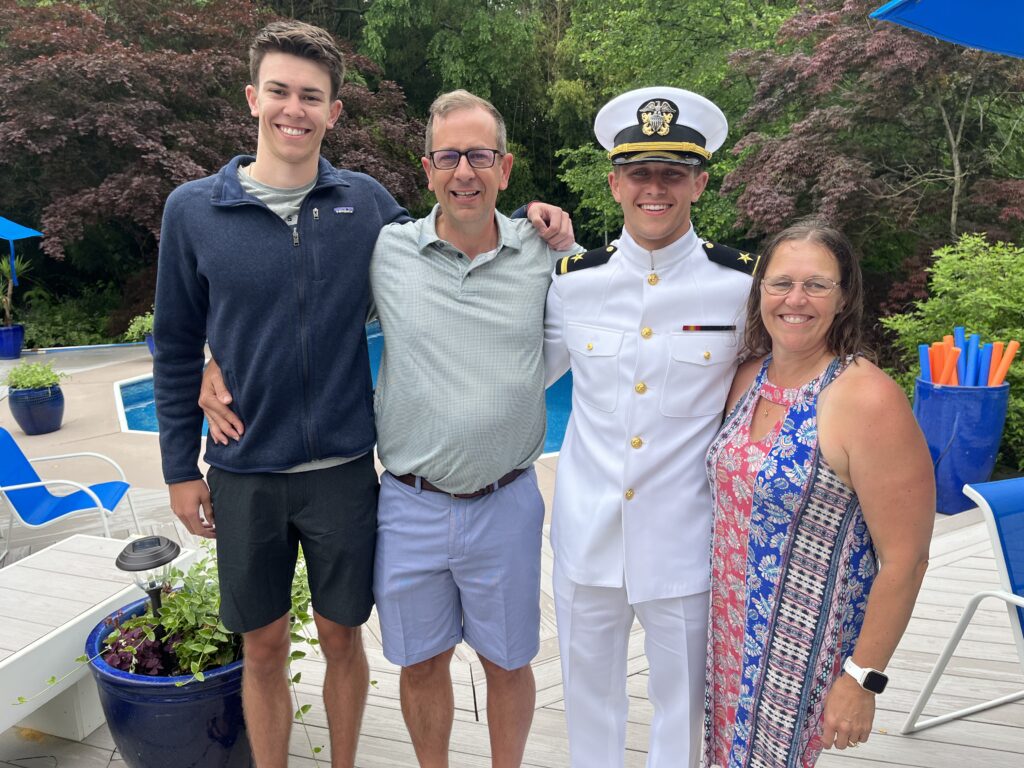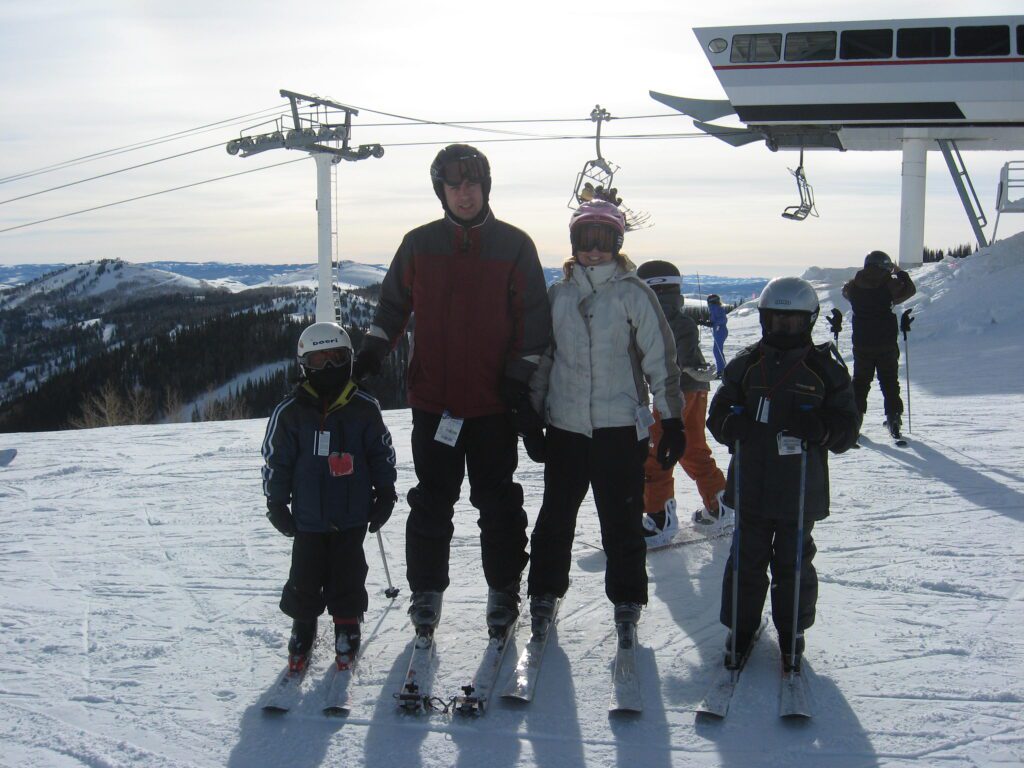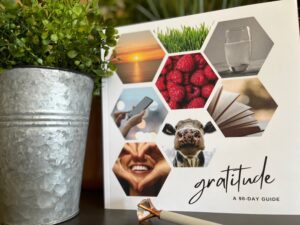Written by Jeremy Hawkins

Professor Matt Gage
When I think of finding blessings in adversity, my mind automatically jumps to Professor Matt Gage. I first met Matt in 2005. He and his wife Michel had taken a leap of faith, moving their family of four from Iowa to Utah to begin working on a PhD. Although Matt and I worked closely over the next four years, I realized I didn’t get to know him as well as I thought. While interviewing him last week, I learned more about his story. I’m excited for you to get to know him a little bit through this blog post.
Matt was born and raised in New Hampton, Iowa. He lived with his mom, an elementary school teacher, his dad, who owned a plumbing and heating business, and his brother, who is 7 years older than him. Matt shared that his family attended the Lutheran church growing up, but that he didn’t go by choice. Every Sunday morning his dad would come into his room and say, “It’s time for church.” It would usually take him coming back two more times before Matt would get up and get ready. Matt told me this story to illustrate that he didn’t truly know Christ as a kid. It wasn’t until after college that he accepted Christ into his life and began building a personal relationship with Him.
Forever Changed
Matt’s life forever changed when he was 9. While visiting family that summer, Matt and his cousin went to the community pool one day to cool off. The two of them were taking turns diving off the side of the pool and swimming to the surface. After one dive, Matt suddenly couldn’t move his left side. He remembers his cousin diving in to help him get to the side of the pool but doesn’t remember much else. Matt’s next memory is waking up at the Mayo Clinic, about a 2-hour drive from where the incident happened.
Tender Mercies
As Matt tells the story, getting to the Mayo Clinic was a tremendous blessing that included many tender mercies. One was a paramedic who insisted that Matt was not suffering from heat stroke. He told Matt’s dad that Matt needed better medical care than the local hospital could provide. This led to Matt’s dad demanding he be transferred by ambulance to the Mayo Clinic. Another mercy was family connections that ensured Matt made it safely to the hospital after the first ambulance he was in overheated on the side of the road.
Trying Anyway
The surgeons working on Matt at the Mayo Clinic determined he’d had a stroke and an aneurysm. They told his parents that if he lived through the needed operation he may be in a vegetative state for the rest of his life. After coming through the surgery Matt was told that he may never walk again. He tried anyway. This comment fueled his desire to get better. Those who know Matt will attest that telling him he can’t do something motivates him all the more.
“You Have Choices”
Recovering from that life-changing time was not without challenges, but Matt’s desire, perseverance, and refusal to settle have paid off. He has limited use of the left arm and leg but hasn’t allowed that to inhibit him. Matt was a key member of his high school basketball team. He also helped with his high school’s football team. He attended college and graduated with a bachelor’s degree in elementary education and three minors. This came after his high school guidance counselor said he “wasn’t college material”. Eventually, a refusal to settle for less led Matt to his future career, athletic training. He faced barriers but he worked through them. Through it all he held to advice from his dad given after his stroke – “You have choices.”
Puzzle Pieces
I enjoyed listening to Matt discuss how the puzzle pieces of his life1 have come together. Those pieces have included time at Eastern Kentucky for a master’s degree, a job offer back at the University of Northern Iowa with a mentor who means the world to him, and completing a PhD at an institution where he was not of the same religion as most students, yet thrived. Through his accounts of each of these experiences, two common themes emerged. First, Matt trusted Christ to provide and Christ did, in abundance. Second, Christ put Matt in the right place, at the right time, and with the right people. I left the interview warmed and inspired by Matt’s faith.
A Few Thoughts
As I’ve pondered how to apply Matt’s experiences to my life, a few things have come to mind:
- Matt told me that there were times when he viewed the physical limitations caused by his stroke as a disability. However, with years and perspective, he now sees them as a gift. He would not choose to change what he has gone through.
- What limitations do I have that are part of my plan that I should see as a gift? Matt’s stroke and aneurysm have allowed him to become acquainted with Christ. Do I allow my struggles to do the same for me?
- Matt knows his ‘why’ for doing what he does. (When he was younger that may have been because he wanted to be the next Michael Jordan!) He has also learned to find and support his ‘why’ with a deep-rooted trust in God. (That is why he is a professor at a Christian university, something he never saw himself doing.)
- Why do I do what I do? Why do you? What role does trusting in God and His plan play in that?
- Matt recognizes that people, places, and experiences come into our lives to help us become what we are meant to be and he is grateful for them. During our interview, he spoke about Terry Noonan, the athletic trainer who got him into athletic training, almost with reverence. The same went for the surgeon who operated on him when he was 9. He also explained that the time he spent working on his PhD was foundational for him. He received an outstanding education as well as many opportunities through the National Ability Center in Park City, Utah. Learning to ski, and being able to ski with his family, was life-changing.
- Who and what has been part of my journey to get me to where I am today, or where I need to be tomorrow? Have I been appropriately thankful for those people and/or those experiences?
(You have probably gathered other things from Matt’s story, in addition to my thoughts. We would love to hear about them in the comments below!)
One Final Thought
I could go on and tell you more about Matt’s journey. Instead, I will close with one final thought from him. It is not a direct quote, but close:
Gratitude helps us have faith and flourish. Make the most of every day. You won’t be perfect at it and will fall short, but we can all help others on the way.
I am grateful for my friendship with Matt. Meeting and working together was a puzzle piece that came together for both of us. He truly is an example to me of finding blessings in adversity. He sees blessings in the place of bothers, and I admire his strength and faith.

References
- The Puzzle We Call Life. Posted on 21 January 2025
Rasband RA. By Divine Design. Liahona. Nov 2017.
Maxwell NA. Brim with Joy. BYU Speeches. Accessed 11 February 2025. ↩︎




